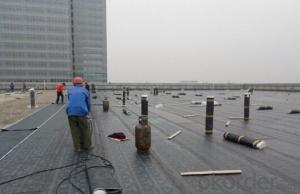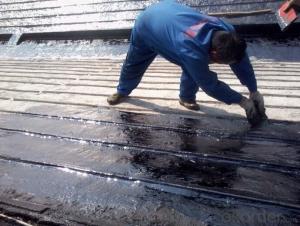Self adhesive SBS bitumen waterproof membrane
- Loading Port:
- Tianjin
- Payment Terms:
- TT OR LC
- Min Order Qty:
- 500 m²
- Supply Capability:
- 100000 m²/month
OKorder Service Pledge
OKorder Financial Service
You Might Also Like
Structure Of SBS Bitumen Waterproof Membrane Description
Self adhesive SBS bitumen waterproof membrane is produced with SBS elastomer and bitumen as raw materials, using polyethylene film. Aluminium foil coated on the upward or no file(both side self-adhesive) while self-adhesive protection layer on the downward surface.It has a widely prospect new contruction waterproof materials. Good self-adhesion, no leaking,cold flexibility,especially in self-adhesion. That is unique product in waterproof and application.
Main Features of the SBS Bitumen Waterproof Membrane
1. Self-adhesive without bonding agent and torching.
2. With good elasticity and elongation, can be used in -25 degree weather.
3. Easy and safe installation, and won't be effected by the weather, greatly reduce the construction period and the cost.
4. Environment protection product.
5. Corrosion resistance and ageing-resistance.
6. Available for wet ground.
SBS Bitumen Waterproof Membrane Images
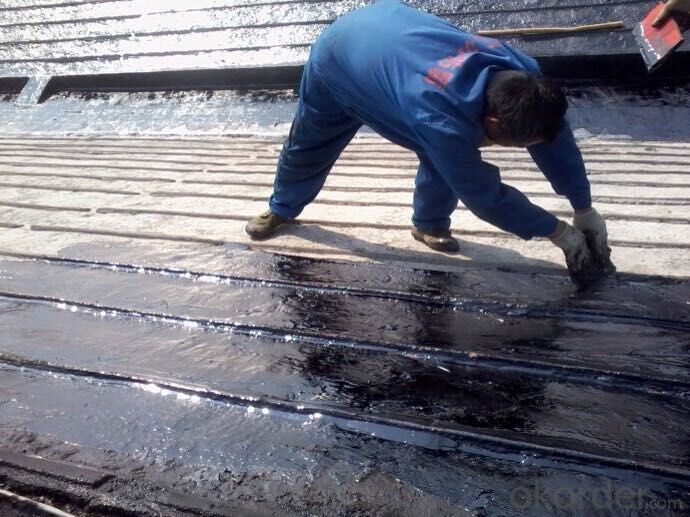
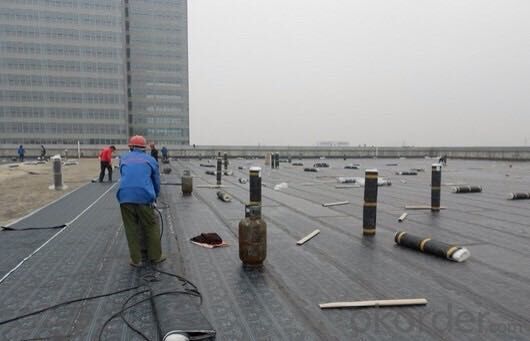
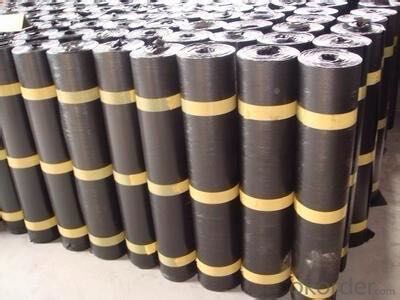
SBS Bitumen Waterproof Membrane Specifications:
1. Size: 1*10mm, 1*15mm, 1*20mm
2. Thickness: 1.5mm, 2.0mm, 3.0mm, 4.0mm
3. Weight: 25kgs, 26kgs, 32kgs, 38kgs.
4. Rolls in 1*20'GP: 800 rolls
FAQ Of SBS Bitumen Waterproof Membrane
1. What is the usage?
SBS/APP modified asphalt waterproofing membrane can be widely used for building surface and basement waterproof in industrial and civil engineering, as well as waterproof for subway, cold storage, airport runway and viaduct.
SBS modified asphalt waterproofing membrane is specially suitable to the architecture’s waterproofing in cold area and to the building of unstable constructions, while APP specially is suitable to areas of high temperature and of strong sunshine.
2. What is the application areas?
1. Balcony, bathroom, kitchen
2. Tunnels, Industrial roofs
3. Flat and sloped roofs
4. Basements, Foundation and retaining walls
5. Gardens, Bridges
- Q:Are waterproofing membranes suitable for high-traffic areas?
- Yes, waterproofing membranes are suitable for high-traffic areas. These membranes are designed to provide excellent durability and resistance against heavy foot traffic. They create a protective barrier that prevents water from seeping through and damaging the underlying structure. Additionally, waterproofing membranes can withstand the wear and tear caused by constant use, making them an ideal choice for areas with high foot traffic such as commercial spaces, parking garages, or outdoor walkways.
- Q:Does a waterproofing membrane provide any UV resistance?
- Yes, a waterproofing membrane can provide some degree of UV resistance. Many waterproofing membranes are designed to be used in outdoor applications where they will be exposed to sunlight. These membranes often incorporate UV stabilizers or additives that help to protect the membrane from the damaging effects of UV rays. However, it is important to note that the level of UV resistance provided by a waterproofing membrane can vary depending on the specific product and manufacturer. It is always recommended to consult the manufacturer's specifications and guidelines to determine the UV resistance capabilities of a particular waterproofing membrane.
- Q:Can waterproofing membranes be used on mechanical equipment rooms?
- Yes, waterproofing membranes can be used on mechanical equipment rooms. Waterproofing membranes are commonly used to protect various types of structures, including mechanical equipment rooms, from water damage. These membranes create a protective barrier that prevents water infiltration, ensuring the longevity and proper functioning of the equipment and reducing the risk of water-related issues such as corrosion or electrical damage.
- Q:Can a waterproofing membrane be used for a rooftop garden protection?
- Indeed, rooftop garden protection can be achieved through the utilization of a waterproofing membrane. Specifically formulated to impede water penetration, this type of membrane proves to be an optimal selection for safeguarding a rooftop garden. By establishing a protective barrier, it effectively bars water infiltration, thus averting any possible harm to both the rooftop's structure and the garden's flora. Furthermore, certain membranes provide supplementary advantages, including resistance to UV rays and roots, thereby augmenting their suitability for the safeguarding of rooftop gardens.
- Q:Can a waterproofing membrane be used on precast nickel surfaces?
- Yes, a waterproofing membrane can be used on precast nickel surfaces. The membrane will provide a protective barrier against water penetration, helping to prevent moisture damage and corrosion on the nickel surface.
- Q:Can a waterproofing membrane be used for water tanks?
- Water tanks can indeed utilize a waterproofing membrane. These membranes are specifically designed to halt the passage of water and effectively seal water tanks, guaranteeing their watertightness. Commonly composed of materials like bitumen, PVC, or EPDM, these membranes possess remarkable water resistance and can endure the challenging conditions typically present in water tanks. Moreover, waterproofing membranes can be applied to various surfaces, including concrete, metal, and masonry, making them versatile and suitable for different types of water tanks. All in all, the usage of a waterproofing membrane presents a reliable solution in safeguarding the integrity and longevity of water tanks by preventing water leakage and shielding the surrounding environment from potential water damage.
- Q:Roof SBS waterproofing membrane additional layer needs to be wide
- The waterproofing membrane is a curlable sheet-like waterproofing material. Is one of the important varieties of waterproofing materials in construction engineering. According to the brand classification Construction industry waterproofing membrane mainly Dike waterproof membrane, DuPont waterproofing membrane, Sicon waterproofing membrane, which the first two participating GB chart set. According to its main waterproof composition material can be divided into asphalt waterproof material, high polymer modified waterproof membrane and synthetic polymer waterproofing membrane (SBC120 polyethylene polypropylene composite membrane) three categories. There are PVC, EVA, PE, ECB and other waterproofing membrane
- Q:Are there any specific considerations for installing a waterproofing membrane on sloped surfaces?
- Yes, there are several specific considerations for installing a waterproofing membrane on sloped surfaces. Here are a few important ones: 1. Proper slope: It is crucial to ensure that the slope of the surface is appropriate for drainage. The slope should be designed to allow water to flow away from the surface and prevent any pooling or ponding. This will help in avoiding water penetration and potential damage to the membrane. 2. Compatibility with slope materials: It is important to consider the compatibility of the waterproofing membrane with the materials used on the slope. This includes ensuring that the membrane adheres well to the slope surface and does not react negatively with any other materials present. 3. Anchoring and fastening: On sloped surfaces, proper anchoring and fastening of the waterproofing membrane is important to ensure its stability and longevity. This may involve using additional mechanical fasteners or adhesives specifically designed for sloped surfaces. 4. Transition and edge details: Sloped surfaces often have transition areas or edges where the waterproofing membrane meets other surfaces, such as walls or adjacent slopes. These areas require specific attention to ensure a proper seal and prevent any water infiltration. 5. Drainage systems: Sloped surfaces may require the installation of additional drainage systems to effectively manage water runoff. This may include the use of drains, gutters, or downspouts to divert water away from the waterproofing membrane. 6. Quality of installation: Installing a waterproofing membrane on a sloped surface requires careful attention to detail and proper installation techniques. It is important to follow the manufacturer's instructions and industry best practices to ensure a successful and durable installation. Overall, installing a waterproofing membrane on sloped surfaces requires a thorough understanding of the unique challenges and considerations involved. By addressing these specific factors, you can ensure effective waterproofing and protection for your sloped surface.
- Q:Can a waterproofing membrane be used in crawl spaces?
- Yes, a waterproofing membrane can be used in crawl spaces to prevent moisture infiltration and protect the space from water damage.
- Q:Can waterproofing membranes be used in swimming pools?
- Yes, waterproofing membranes can be used in swimming pools. Waterproofing membranes are commonly used in swimming pools to prevent water leakage and to protect the structural integrity of the pool. These membranes are typically made of durable materials, such as PVC or EPDM, that are designed to withstand constant exposure to water and pool chemicals. They are applied to the concrete or other pool structures to create a watertight barrier that prevents water from seeping through. Additionally, waterproofing membranes can also provide protection against cracks, corrosion, and other forms of damage, ensuring the longevity and durability of the pool.
1. Manufacturer Overview |
|
|---|---|
| Location | |
| Year Established | |
| Annual Output Value | |
| Main Markets | |
| Company Certifications | |
2. Manufacturer Certificates |
|
|---|---|
| a) Certification Name | |
| Range | |
| Reference | |
| Validity Period | |
3. Manufacturer Capability |
|
|---|---|
| a)Trade Capacity | |
| Nearest Port | |
| Export Percentage | |
| No.of Employees in Trade Department | |
| Language Spoken: | |
| b)Factory Information | |
| Factory Size: | |
| No. of Production Lines | |
| Contract Manufacturing | |
| Product Price Range | |
Send your message to us
Self adhesive SBS bitumen waterproof membrane
- Loading Port:
- Tianjin
- Payment Terms:
- TT OR LC
- Min Order Qty:
- 500 m²
- Supply Capability:
- 100000 m²/month
OKorder Service Pledge
OKorder Financial Service
Similar products
New products
Hot products
Hot Searches
Related keywords

